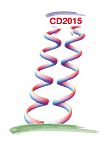Speaker
Aron Bernstein
(Massachusetts Institute of Technology, Cambridge)
Description
The pi^0 rightarrow gamma gamma decay rate is dominated by the QCD axial anomaly that is increased by approx 4.5% +- 1.0% by the mixing of the pi^0 wave function with the eta, eta^' mesons. This relatively large isospin breaking effect is proportional to the mass difference of the up and down quarks. It has been calculated in Chiral Perturbation Theory (ChPT) by three slightly different methods with good agreement between them. This is a solid QCD prediction; the error is due to the uncertainty due to our knowledge of the low energy constants of ChPT and not by higher order terms.The accuracy of the present experiments are significantly less than the theoretical prediction and represents a significant experimental challenge. A summary of the three three experimental methods to perform this measurement and current efforts to improve them will be briefly reviewed with emphasis on one by the COMPASS collaboration at CERN.
For the pi^0 -> gamma gamma* decay the form factor can be written as F(Q^2) = F(0)(1 -R(pi^0)^2 Q^2/6 +...) at low Q^2. This suggests a possible way to measure the size ("anomaly radius") of the pi^0 meson which does not have a charge or magnetic radius. Using the latest, most accurate, calculated value of the slope parameter obtained from a dispersive analysis of the pion transition form factor, this RMS radius is 5% smaller than the pi^pm electric radius. Using vector dominance these radii are expected to be equal. However this similarity, and the difference between these values, calls for a careful theoretical and experimental examination of this fundamental quantity. Clearly the charge and "anomaly" radii correspond to the expectation values of different operations. A comparison of the scalar and electromagnetic radii of the pion and proton with some interesting (puzzling?) differences will be presented.
Primary author
Aron Bernstein
(Massachusetts Institute of Technology, Cambridge)

